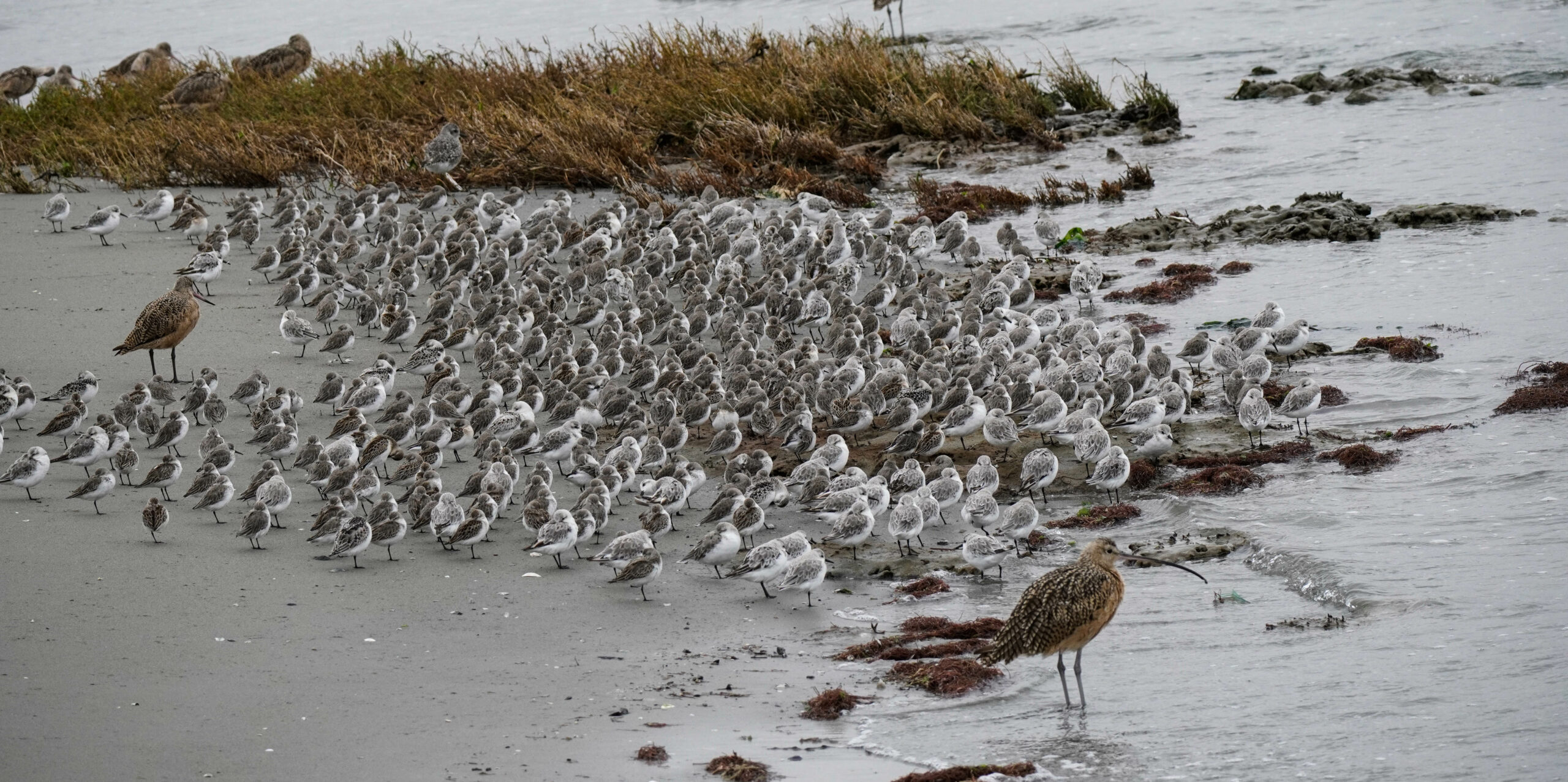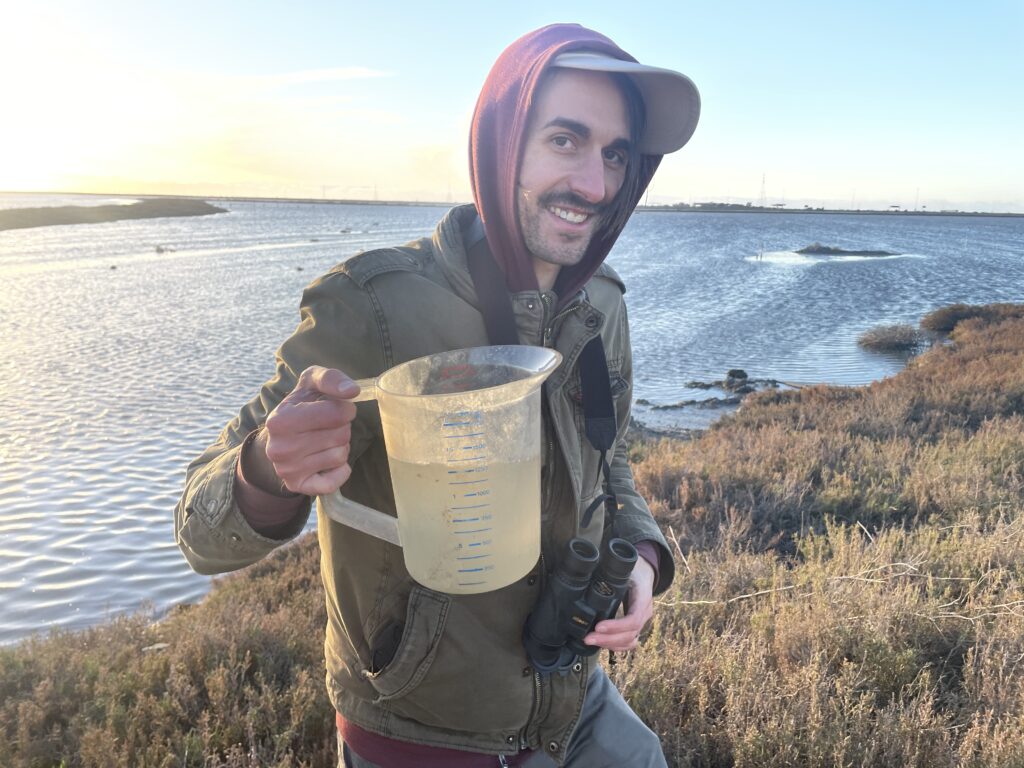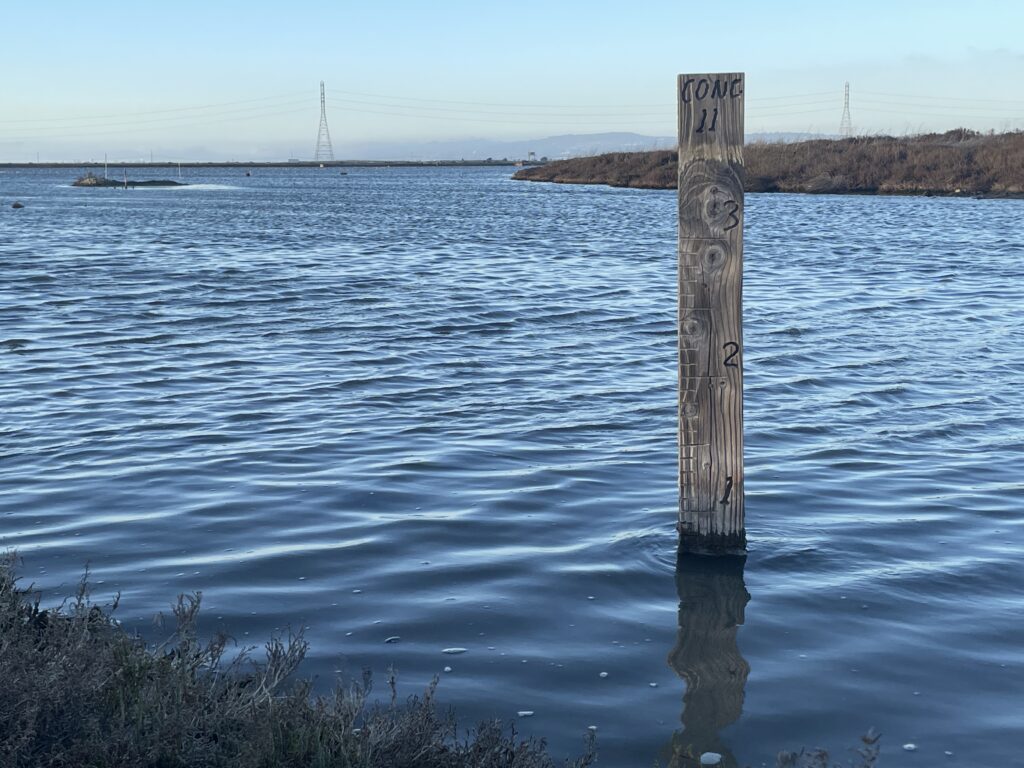
It’s high tide at Eden Landing Ecological Reserve, on San Francisco Bay due west of Union City, and Nathan Van Schmidt is counting birds on Pond E9 with both hands. Van Schmidt, science director for the San Francisco Bay Bird Observatory, has a clicker in his right hand to track American Avocet, and another in his left for Northern Shoveler. “Wetlands can support an incredible biomass of birds,” he says. “And Eden Landing is one of the birdiest places in the Bay.”
The Observatory, a local nonprofit bird conservation organization, helps the South Bay Salt Pond Restoration Project to monitor how birds are doing on 82 managed ponds and restored tidal wetlands. This pond, with water levels maintained at about a foot, is perfect foraging habitat for larger shorebirds and dabbling ducks like the ones Van Schmidt is counting. But you won’t find small, migratory shorebirds such as the threatened Western Snowy Plover on Pond E9; they’re much more likely be spotted on Pond E14, which the restoration consortium manages as a mudflat with lots of oyster shells spread on the ground to provide camouflage from predators for the teeny-tiny white-and-brown birds.
Small shorebirds prefer mudflats, Van Schmidt explains, while dabbling ducks and larger waterbirds need shallow ponds, and diving ducks and large waterbirds thrive in deeper ponds. Tidal wetlands can support different species depending on how high the tide is. “It’s a balancing act,” he says. “Which bird species will have more habitat in which type of wetlands restoration? We don’t know the answers to these questions. That’s why we’re out here monitoring.”

The San Francisco Bay and Delta are critically important for millions of birds, with a million or so stopping to rest, refuel, and breed as they migrate north or south along the 10,000-mile Pacific Flyway. For millennia, Indigenous Ohlone people hunted at the edges of the Bay for abundant waterfowl, using nets and traps. When European immigrants arrived in the Bay Area, they marveled at the massive numbers of waterfowl that reportedly blackened the sky when flocks alighted. By the mid-20th century, 80% to 90% of the Bay Area’s tidal marsh had been drained and repurposed, and populations of migratory and resident birds that rely on wetland habitat declined precipitously.
Across North America, bird populations have been in freefall since the mid-19th century due to habitat loss, overhunting, and environmental degradation. An October 2019 study in Science estimated that 3 billion birds have been “lost” in the United States and Canada since 1970, representing a 29% decline in their overall abundance. “We’re missing 3 billion birds, and I don’t know where we’re going to find them,” says Steve Beissinger, UC Berkeley professor of conservation biology. “But the one group that’s doing better is the wetland birds. Their decline has slowed down.”
Wetlands habitat is undoubtedly making a slow comeback around the Bay. In its 2019 State of the Estuary Report, the San Francisco Estuary Partnership found that the status of tidal marsh ecosystem—a key indicator of estuary health, and essential habitat for waterbirds like ducks and shorebirds—is trending upward. “Tidal marsh restoration is proceeding at a brisk pace in the Bay and gaining traction in the Delta,” wrote Letitia Grenier, the partnership’s lead scientist.
Restoring tidal action to former wetland areas invariably means more birds, Beissinger says. “In the Bay, when we recreate wetlands where they used to be, there’s a good chance that they’re going to be used. If you follow the water, you start to see which conditions are attractive for birds.”
Research conducted in Beissinger’s lab at UC Berkeley—where Van Schmidt did his doctoral work—followed the water and found that the secretive, state-endangered California Black Rail was successfully (and amazingly) breeding in artificial wetlands that were created intentionally or accidentally by leaky irrigation pipes, all over the foothills of the Central Valley.
Across the Bay and Delta, water and wildlife agencies—in partnership with bird advocacy organizations—have spent the past few decades restoring and recreating intentional wetlands to provide bird habitat and protect threatened and endangered species such as the Western Snowy Plover, Ridgway’s Rail, Giant Garter Snake, and Salt-marsh Harvest Mouse. Some new wetlands are created by breaching levees and restoring tidal flows, while others are made by adding water to former salt ponds at different levels, as managed ponds.
Beginning in the mid-19th century, more than 50,000 acres of wetlands around the Bay were drained to create huge flats for drying out salty brine. A century later, Cargill—owner of the ponds—donated or sold more than 40,000 acres for wetlands restoration, which were in turn transformed into the Don Edwards San Francisco Bay National Wildlife Refuge (1979), Napa-Sonoma Marshes Wildlife Area (1994 and 2003), and South Bay Salt Pond Restoration Project (2003). (Cargill still harvests salt from more than 12,000 acres around the Bay.)
The South Bay project is managed by a consortium of federal and state agencies and nonprofit organizations, led by the U.S. Fish and Wildlife Service and California Department of Fish and Wildlife. Their aim is to restore 50% to 90% of 15,100 acres of former South Bay salt evaporation ponds to tidal marsh over the next 50 years (see Taking the Measure of Success).
Researchers from the San Francisco Bay Bird Observatory are out monitoring birds at the South Bay Salt Pond Restoration Project five days a week, and they visit each pond at least once every six weeks. After counting the birds, Van Schmidt takes note of cloud cover and measures air temperature and other environmental factors. He uses a handheld sonde instrument to monitor the pond’s water level, salinity, pH, and dissolved oxygen.
Scientists like Van Schmidt have come to understand that there are bird winners and bird losers when full tidal action is restored to salt ponds. A 2002 study by Point Blue Conservation Science (then known as Point Reyes Bird Observatory), U.S. Geological Survey, and San Francisco Bay Bird Observatory showed that the Bay’s salt ponds were supporting 75 waterbird species, which added up to more than a million birds at high tide. “Restoring salt ponds to tidal marsh should proceed with caution to avoid loss of waterbird diversity and numbers in San Francisco Bay,” the researchers warned.

“We’re taking years of data collected in North and South Bay salt ponds, evaluating it for how birds are responding to habitat changes that have already happened, and using that information to support wetland restorations and management in the future,” says Susan De La Cruz, research wildlife biologist with the Geological Survey’s Western Ecological Research Center in San Francisco Bay. “We’re doing a lot of studies about tweaking managed ponds. Once you breach a habitat, it’s much less of a controlled environment.”
Because two-thirds of the salt ponds in the Napa-Sonoma Marshes Wildlife Area have already been restored to tidal action, research conducted in the North Bay has been invaluable for managing ponds and restoring tidal marsh in the South Bay. To improve the suitability of this new habitat for waterbirds, land managers are adjusting the depths and salinity of the managed ponds there and constructing islands and berms to create breeding and roosting areas that meet the needs of different birds. “Conditions are getting better for the birds in managed ponds,” De La Cruz says. “They are more able to support a wide variety of birds because of salinity and management changes.”

At the same time that tidal wetlands around the Bay were being drained, a vast network of levees was being constructed across some 400,000 acres of the Delta to manage water supplies and create farmland. Left with only scattered patches of wetlands, primarily in Suisun Marsh and the western Delta, migratory and resident birds in the Delta and Central Valley now rely on managed seasonal wetlands, flooded rice fields, and harvested corn for food supplies.
The Delta Plan is a state-mandated strategy to maintain reliable water supplies for urban and agricultural uses, while restoring Delta ecosystems. An overarching goal is to “restore habitat necessary to avoid a net loss of migratory bird habitat and, where feasible, increase migratory bird habitat to promote viable populations of migratory birds.”
Chapter 4 of the plan establishes the long-term goal of restoring tidal flows to about 10% of the Delta and Suisun Marsh, about 60,000 to 80,000 acres. In addition, the plan sets goals for the restoration of riparian and nontidal wetlands, which are also important for birds. Likewise, California EcoRestore, a multiagency project led by the California Department of Water Resources, aims to restore 30,000 acres of tidal marsh habitat in the Central Valley and Delta.
But these big goals still need to be translated into specific restoration plans that include consideration of bird habitat needs, says Julian Wood, San Francisco Bay program leader for Point Blue. “On the planning side, we need to set more-specific bird conservation objectives for the Delta, similar to what the Central Valley Joint Venture has done for the whole valley. We need to strategically locate restoration efforts in places that will expand on areas that are already really valuable for birds.”
To that end, Point Blue is identifying “Priority Bird Conservation Areas” in the Delta to help land managers and planners support conservation and adaptation actions that provide benefits for multiple species of birds, says Kristen Dybala, Point Blue’s principal ecologist for the Pacific Coast and Central Valley.
“We need restored natural wetlands and bird-friendly agricultural practices that provide varied habitats to support diverse bird populations in the Delta,” Dybala says. “The more we address flood protection, water storage, and other basic needs using nature-based solutions, the easier it will be to keep birds off the endangered species list.”
The dull hum of the freeway makes it across Pond E9 to the monitoring site at Eden Landing, but the random peeps of waterbirds break through. A seal pops up its head in the channel, and a White-tailed Kite hovers overhead.
Van Schmidt uses two hand counters to track about 1,500 American Avocet, 500 Northern Shoveler, and small numbers of Dunlin, Northern Pintail, Dowitcher, Black-bellied Plover, Canada Goose, and Black-necked Stilt. He recalls with amazement a day when he counted 5,000 Ruddy Duck on a nearby pond.
Of course, restoring wetlands isn’t just for the birds. The ecosystem benefits include water filtration, flood protection, and carbon sequestration. “Acre for acre, restored wetlands collect a lot of carbon compared to other habitat types in California,” Van Schmidt says.
Beissinger says that as sea levels rise in response to climate change, all that water will need somewhere to go. “Restoring wetlands now, so that rising waters have the opportunity to shift as things change, is going to be really important. And, yes, if you build it, they will come. That’s one of the nice things about most birds—they fly.”
Top Photo: Shorebirds on restored habitat. Credit: U.S. Geological Survey, William Chan
Trends and habitat associations of waterbirds using the South Bay Salt Pond
Restoration Project, San Francisco Bay, California (U.S. Geological Survey)
The critical role of islands for waterbird breeding and foraging habitat in managed ponds of the South Bay Salt Pond Restoration Project, South San Francisco Bay, California (U.S. Geological Survey)
Chapter 4 of Delta Plan (Ecosystem Amendment), “Protect, Restore, and Enhance the Delta Ecosystem” (Delta Stewardship Council)
Getting Our Heads Above Water: Integrating Bird Conservation in Planning, Science,and Restoration for a More Resilient Sacramento–San Joaquin Delta (San Francisco Estuary & Watershed Science)